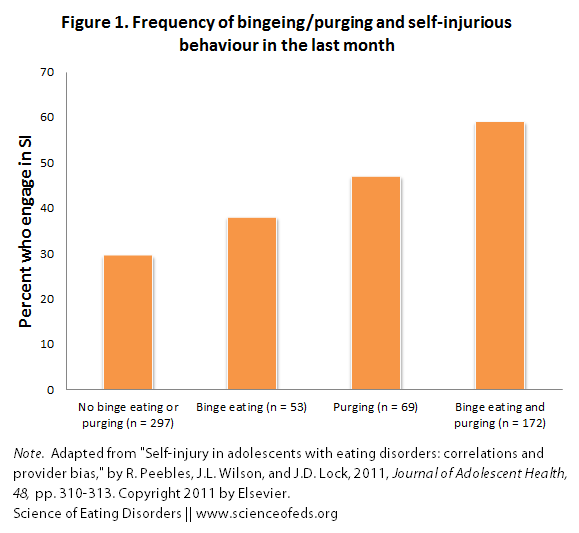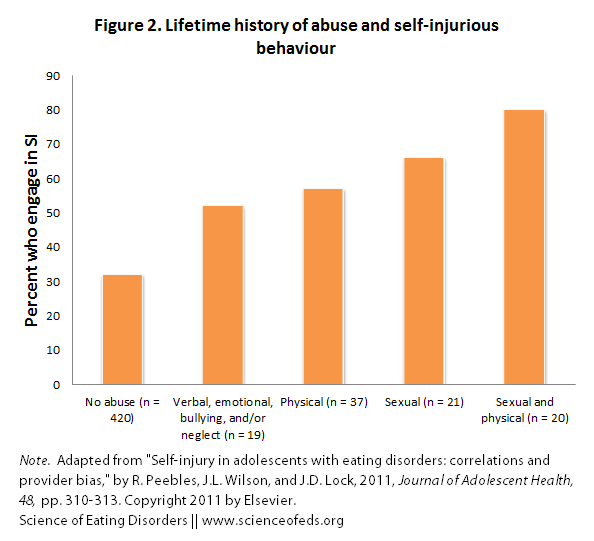Self-harm or non-suicidal self-injury (SI) are common among adolescents, particularly among adolescents with eating disorders. Previous studies have shown that SI seems to be associated with sexual trauma, mood disorders, and substance abuse. The present study aimed to find out whether (1) SI is associated with any specific eating disorder symptoms, such as bingeing, or purging, and (2) how often clinicians screen for SI behaviours (and whether particular patients are more likely to be screened than others).
Dr. Rebecka Peebles and colleagues looked retrospectively at intake evaluations of 1,432 patients between the ages of 10-21 (mean age 15). Three quarters of the patients were Caucasian, and slightly over 9% were male. Sixty-three percent had an intake diagnosis of eating disorder not otherwise specified (EDNOS).
MAIN FINDINGS FOR AIM 1
- Of those screened for SI behaviours, 40.8% engaged in SI
- Cutting was the most common SI behaviour reported (85%)
- Bingeing/purging was highly associated with SI (see figure 1 below)
- History of abuse was also highly associated with SI (see figure 2 below)
- Patients who engaged in SI were also more likely to use antidepressants (though we can’t draw any conclusions about causation here)
MAIN FINDINGS FOR AIM 2
- Only 42.7% of patients were screened for SI behaviours
- Clinicians were more likely to screen for SI in patients who:
- were older
- had the ED for longer
- had a history of binge eating, purging, substance use, abuse
- were diagnosed with bulimia nervosa
These findings suggest that health care providers who do intake evaluations and screen for various behaviours might be biased as “they were more likely to screen patients who fit a profile of a self-injurer.” This means that the associations between bingeing/purging and history of abuse may or may not remain once providers screen all incoming patients for SI. This is because the associations above are based only on 42.7% of patients, we don’t know about the SI status of the other 57.3%.
This means that more effort must be made to ensure that all clinicians and intake nurses/staff screen every incoming patient for SI behaviours.
Effective and standardized provider screening is essential given the high rates of [SI behaviours] among both adolescents and patients with ED who are screened, and the increased risk for suicide in those who self-injure. Further prospective study is warranted to determine the true prevalence in ED adolescents, as these results could be biased by such selective screening.
Readers, what do you think of the findings in this study? Do you think the associations between bingeing/purging and history of abuse with SI make sense?
Out of curiosity, when you were evaluated for an ED, where you screened for SI?
References
Peebles, R., Wilson, J., & Lock, J. (2011). Self-Injury in Adolescents With Eating Disorders: Correlates and Provider Bias. Journal of Adolescent Health, 48 (3), 310-313 DOI: 10.1016/j.jadohealth.2010.06.017


I think once a history of BP has been established it is reasonable to probe for a history of SI – that said, BP tends to occur AFTER a long ED history – as does SI and co-morbid drug use, etc. . . So the relationship between a particular ED and form of self-harm may reflect a longer or more diverse history of ED. . .
However, (and I haven’t read much of the BN/B/P literature) perhaps the self-harm co-occurs with the ED in which case it would have nothing to do with the type/symptoms of ED. . .
Personally, I know I began to self-harm after my first in-patient stay. I remember thinking to myself that it was as “good as exercise” in terms of relieving that “icky” feeling and that was why I continued doing it – i.e emotional regulation. . .
I have never been BN – Only AN-R, AN-P, and ED-NOS, but I wonder how many have sought self-harm as similar comfort? I mean what can you do if you cannot starve?
Good points, but I do think history of SI should be done regardless of diagnosis and duration of ED. Based on my completely unscientific and totally not-random sample of people on tumblr that I follow, there seem to be a lot of individuals with just AN or AN-P who self-harm. If SI is associated with a higher likelihood of suicide, and suicide rates seem to be similar enough among patients with different ED diagnoses, I think everyone should be screened.
It is unfortunate how SI occurred during treatment for you. It reminds me of a passage in “Slim to None” (the only ED book I’ve read and own) where she talks about how frustrating it is to have to eat, not be able to purge, and yet have no/very little support to deal with the guilt and overwhelming amount of feelings that arise as a result of eating. I can see how SI would start at that point.
I’ve never self-harmed or been suicidal, but I imagine that the release from SI is probably similar to bingeing/purging? I bet probably more so to bingeing/purging than just purging because bingeing means you’ve just consumed a ridiculous amount of food and so the guilt and shame is likely much worse than with eating a normal meal (of course, that’s anxiety-provoking too, there’s no denying that).
I wanted to answer your question about the feeling of release from SI being similar to bingeing/purging. For me, it was similiar in some ways such as it calmed me down. I also felt SI was a form of self-punishment as was purging.
It was different though because the release wasn’t as “freeing” I guess I would say. With bingeing and purging I felt like I was breaking all the rules and that was a strong release whereas with SI it was a release because of seeing the blood and the letting go of the build-up of tension.
I definitely agree that everyone who is diagnosed with an ED should be screened for SI. I wonder about the connection between bulimia and SI. In my personal history I was anorexic, then bulimic, and then I started SI. Usually I would use SI as a substitute for bingeing/purging.
I had anorexia nervosa at the age of 19. I never engaged in self harm, like cutting on myself, but at the age of 21 I did have have a suicide attempt. This attempt was very specific to the fact that an insurance policy stopped its coverage and I could no longer live with this disorder for the rest of my life. I went into recovery at the age of 22yr.I always had specific hang ups about food and weight but I maintained a stable weight and went to college to become a nurse. I function well for many years. I went back I to the self-starving mode last year. I am now faced with treatment again. To me this in itself is self-harm. I feel it’s its an unconscious desire to die.
I think screening for SI and suicidal thoughts should be done automatically on every intake for a mental health issue – maybe it should be done among all young people at least. I wonder are there any figures about these peoples ages – is self injury more prevalent in any particular age group? I wouldn’t mind betting adolescence/young adulthood showed the greatest number.
When I first self harmed I had never been diagnosed yet with the ED, although I was very close to being so, I had never been in a mental health facility, or had contact with other people with mental illness (that I knew of). I had no idea that people DID that and didn’t know why I did it either. I was in my late teens and highly emotional – I look back now and often thank God that I don’t feel things as intensely as I did when I was younger. At that time I was in excruciating mental pain, and although the SI co-existed with my ED, it really didn’t have any other ties with it, wasn’t caused by it that I know of. It was another way of me trying to tolerate emotional pain that I just didn’t think I could get through in one piece.
I do think it’s similar to purging, but I also think it can create a pain that’s actually more bearable because it’s tangible as opposed to a mental pain that the person often cannot put into words or even understand why they feel that way. I know for me, concentrating on the injury and feeling the corresponding pain helped me tolerate/survive the mental pain for a while.
PS i don’t know what’s happening because I stuffed it up, realised I had not entered my details, tried to stop it, and now.. argh. I apologise if this has been posted already.
This fits my personal history very well. I have a history of verbal/emotional abuse and started SI behaviors on the onset of puberty. I began AN-P behaviors about a year later. Upon my intake, they screened for the SI and asked about suicidal thoughts. I believe that they did this for all patients.
I don’t necessarily believe that I was suicidal. The purging and SI filled similar roles. They both relieved anxiety and had a calming effect. Incidentally, when I was doing outpatient therapy, I would be there from breakfast to dinner most days. I would eat dinner, leave, go home, and then engage in both SI and purging in succession. It was compulsive at that point to relieve anxiety and fulfilled a “punishment” role for me. This thought process about punishment is also probably heavily related to the abuse history.